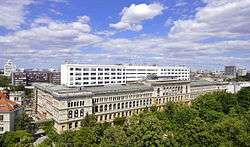European Institute of Innovation and Technology
 | |
| Established | 11 March 2008 |
|---|---|
| Mission |
· Contribute to the competitiveness of Europe, its sustainable economic growth and job creation by promoting and strengthening synergies and cooperation among businesses, education institutions and research organisations. · Create favourable environments for creative thought, to enable world-class innovation and entrepreneurship to thrive in Europe. |
| Focus | Innovation & Technology |
| Chairman | Dirk Jan van den Berg (Governing Board) and Martin Kern (Interim Director) |
| Budget | €2.4 billion for 2014–2020 |
| Location |
|
| Website | eit.europa.eu |
The European Institute of Innovation and Technology (EIT) is an independent EU Body, headquartered in Budapest, Hungary. It was established on 11 March 2008.[1]
Concept
The idea of a European Institute of Innovation and Technology (EIT) was developed within the framework of the Lisbon Strategy. The initial concept for a European Institute of Technology was based on the Massachusetts Institute of Technology, which is renowned for its combination of world-class education and research.[2] In its proposal for an EIT, the European Commission put forward a two-level structure that combines a bottom-up and top-down approach as a governance structure. The proposal of the Commission was based on the results of a wide public consultation taking more than 700 contributions by experts and the general public, and various stakeholder position papers into account.
The Commission identified five specific areas of concern:
- Translating R&D results into commercial opportunities
- Reaching a critical mass in certain fields
- Fragmentation of the EU’s research and higher education system
- Lack of innovation and entrepreneurial culture in research and higher education
- Lack of a critical mass in small- and medium-sized enterprises
Knowledge Triangle

The answer to these issues would focus on integrating the three sides of the so‑called "Knowledge Triangle": higher education, research, and business sectors. The concept of the EIT has been controversial since the proposal of EC president José Manuel Barroso and considered challenging.[3]
A unique feature of the EIT is the Knowledge and Innovation Communities (Innovation Communities) set up to integrate education, research and innovation (the so-called Knowledge Triangle) in one common organisation. The EIT finances the Innovation Communities with a maximum of 25% of the total budget. While the EIT´s Headquarters are situated in Budapest (Hungary), the EIT is not concentrated in one campus as a traditional institute, instead operating through the Innovation Communities. Each of the Innovation Communities operates across a number of hubs called ‘Innovation Hubs’ and there are currently around 40 Innovation Hubs spread across Europe.[4]
Before, the European Commission had sponsored some pilot projects embracing the Knowledge triangle. The task of aligning different partners and the complexity of building common ground and common rules however proved difficult. Evaluation indicated a high level of trust among the partners, well-designed organizational structures and lean management structures with intelligent performance indicator systems were necessary to make the Innovation Communities successful.[5]
As of 21 January 2008, it appeared that the EIT project would mainly operate by building networks of business, pre-existing universities and research organisations, without building any new education or research Institution and without granting EU diplomas.[6]
History
The EIT was officially established on 11 March 2008 following the adoption of the EIT Regulation [1] by the European Parliament and Council.[7]
The EIT Governing Board designated the first three Innovation Communities in December 2009. Since then, the EIT Community has grown to 6 Innovation Communities. These Innovation Communities have the objective of integrating education, research and innovation in one common organisation. The EIT finances the Innovation Communities with a maximum of 25% of the total budget. While the EIT´s Headquarters are situated in Budapest (Hungary), the EIT is not concentrated in one campus as a traditional institute, instead operating through the Innovation Communities. Each of the Innovation Communities operates across a number of hubs called ‘Innovaiton Hubs’ and there are currently around 40 Innovation Hubs spread across Europe.[4]
Funding
An initial budget of €308.7 million has helped launch and will continue to support the EIT network during the 2008–2013 period.
The annual grant to the Knowledge and Innovation Communities is allocated on a competitive basis and may not exceed 25% of the global expenditure of the Innovation Communities. The remainder of the Innovation Communities' budget must be raised from other sources of financing.
In addition to public funding via the EU budget, the EIT set up the EIT Foundation to attract private sector funds including philanthropic contributions such as donations or bequests. The EIT Foundation no longer operates.
Organization
Governing Board
The EIT Governing Board has 15 members - 12 appointed members and 3 representative members as well as one independent observer from the European Commission.[8] The management team is based at the EIT Headquarters in Budapest. It is in charge of monitoring the activities of the Innovation Communities, building and strengthening relationships with key stakeholders both in Europe and beyond, disseminating Innovation Community results, sharing knowledge, and maintaining close links with other EU bodies with a view to ensuring, implementing, and developing the EIT's strategy.
Headquarters
The EIT Headquarters [9] are located in Budapest, Hungary, in the 11th district's Neumann Janos utca (Infopark, Budapest Science park).
On 18 June 2008, Budapest, Hungary, was chosen by the EU nations to host the headquarters of the institute.[2][10] The Hungarian government welcomed the agreement and said it was a great success for the country.
Five bidders entered the race for the EIT seat, including Budapest; Wroclaw, Poland; Sant Cugat del Vallès near Barcelona, Spain; Jena, Germany; and a joint bid from Bratislava, Slovakia, and Vienna, Austria. According to president Barroso, these applications were evidence of "the strategic and economic interest attached...to this ambitious project".
When the EU research ministers came together at the end of May, the decision had to be postponed because Poland vetoed the otherwise unanimously backed city of Budapest as the EIT seat. Yet, the ministers had agreed on the selection criteria, namely that the seat should be in one of the new Member States and it should be in a Member State that does not currently have a European agency or institute. Among the five bidders, only Budapest met those requirements. The President Barroso congratulated Hungary on its achievement: "This is also the result of Hungary's long tradition in excellence in education, research and innovation. Setting the EIT in Budapest represents a flagship for excellence in the knowledge triangle."
EIT Community

The EIT's Innovation Communities are established across Europe (the European Union and Switzerland) in Innovation Hubs.
- EIT Climate-KIC has locations in Birmingham, UK; Zurich, Switzerland; Berlin, Germany; Paris, France; and Randstad, Netherlands.
- EIT InnoEnergy has locations in Karlsruhe, Germany; Kraków, Poland; Grenoble, France; Eindhoven, Netherlands; Leuven, Belgium; Barcelona, Spain; Lisbon, Portugal; and Stockholm, Sweden.
- EIT Digital has co-location centers in Berlin, Germany; Budapest, Hungary; Eindhoven, Netherlands; Helsinki, Finland; Stockholm, Sweden; Paris, France; Trento, Italy; London, UK and Madrid, Spain. Hubs are located in Sophia Antipolis, France; and in Silicon Valley, USA. The organisation's headquarters are located in Brussels, Belgium.
- EIT Health has headquarters in Munich (Germany) and six co-location centres in London (UK/Ireland), Stockholm (Scandinavia), Barcelona (Spain), Paris (France), Mannheim and Heidelberg (Germany/Switzerland) and Rotterdam (Belgium/Netherlands).
- EIT Food has its headquarters in Leuven/Belgium and additional co-location centres in Warsaw, Poland; Reading, UK; Munich, Germany; and Madrid, Spain.
- EIT Raw Materials has its headquarters in Berlin, Germany and co-location centers in Espoo, Finland; Metz, France; Wroclaw, Poland, Luleå, Sweden; Rome, Italy; Leuven, Belgium; and two regional centres in Freiberg, Germany and in Leoben, Austria.
See also
References
- 1 2 Regulation (EC) No 294/2008 of the European Parliament and of the Council of 11 March 2008 establishing the European Institute of Innovation and Technology
- 1 2 "EU nations pick Budapest for technology institute". Brisbane Times. Fairfax Media. 18 June 2008. Retrieved 2008-06-19.
- ↑ "Europe's innovation hub finally KICs off", Nature, 21 February 2011.
- 1 2 "EIT across Europe"
- ↑ Rohrbeck R. and L. H. Pirelli (2010) "The European Institute of Innovation and Technology: How to steer a multi-stakeholder innovation ecosystem" DIME Conference – Organizing for Networked Innovation, Milano, Italy
- ↑ "Common Position (EC) adopted by the European Council" No. 2/2008 of 21 January 2008.
- ↑ "Unlocking Europe's potential for innovation" IP/08/414
- ↑ "Members of the EIT Governing Board"
- ↑ "EIT Headquarters"
- ↑ Decision Taken By Common Agreement Between The Representatives Of The Governments Of Member States of 18 June 2008 on the location of the seat of the European Institute for Innovation and Technology (EIT) (2008/634/EC), Official Journal of the European Union, L 206/16, 2 August 2008.
External links
- European Institute of Innovation and Technology official website